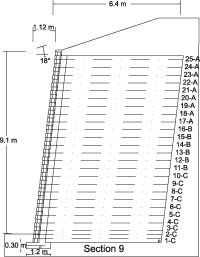Technical Newsletter
Issue 4
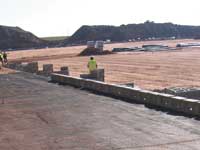
Project Information
Name:
Commercial Project
Chepstow, Wales
Product:AB Classic
Engineers:Peter Brett Associates
Allan Block Manufacturer:
Colinwell Concrete
Belfast, N. Ireland
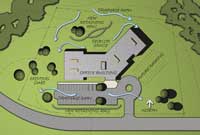
Site Plan

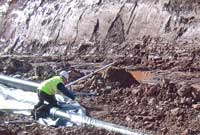
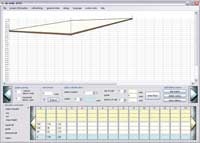
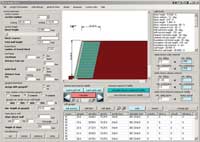

Plan, Design & Build Allan Block in the UK
After crossing the River Severn suspension bridge from England, Chepstow is the first town you arrive at in Wales and the site of the first large commercial Allan Block retaining wall in the United Kingdom. The large retaining walls were needed to level the once sloping fields for the development of two large retail distribution warehouses. The project used the AB Classic with a 6 degree batter and ranged in wall height from 10 ft (3 m) to 30 ft (9 m) and was over 2,300 ft (700 m) long.
Design
Peter Brett Associates (PBA), in cooperation with Huesker Geosynthetics, undertook the design of the Allan Block retaining walls. The main challenge faced was ensuring that the native soils would be suitable backfill material for use within the geogrid reinforced soil mass. Not using the native clays and mudstone would have added a significant impact to the cost of the project. To verify the material properties and ultimate use of the native soils for retaining wall construction, large diameter shear box tests were conducted.
Even though the design was completed by Laurence Tomlin of PBA in England, the results were what you would expect designing a similar retaining wall in North America. In fact, in the July 2008 article, " New Kid on the Block" in Ground Engineering, Laurence wrote:
"The design was in accordance with BS8006:1995 Strengthened / Reinforced Soils and Other Fills. A check was also done using Allan Block’s own in-house software (AB Walls Design Software). Although there are some differences between the US methods and designs based on British standards, there was a reasonable agreement between the outputs for each method."
Construction
Two distinct challenges were faced by the main contractor, Winvic Construction during installation. Using the native clay material for backfill saved money, but also presented its own problems because of the variability in moisture content. If compaction test results indicated that the moisture content was outside the acceptable limits, the earthwork was either put on hold or an alternative onsite source was identified that would satisfy the compaction requirements.
The second challenge was safety during construction. As the Allan Block retaining walls were constructed there needed to be an adequate safety rail along the face. Several options were considered, but eventually it was decided to use scaffolding and attach it to the Allan Block retaining wall units using expanding anchors drilled intermittently into the Allan Block facings.
Managing Water on Retaining Wall Sites
Managing Site Water
Increase your project’s profitability by diminishing the number of callbacks. Water management is a critical aspect to retaining wall design and construction. A project with poor water management can have consequences that are not realized for years after the project’s completion.
Site Design:
During the design phase of the project, it is important to consider surface runoff. Whenever possible, the site should be graded to route water away from the retaining walls. This can be done by establishing the final grade with a positive gradient away from the retaining wall structure or using drainage swales, berms, and catch basins. Remember, catch basins and storm drain manholes should be located behind the reinforced soil mass whenever possible.
During the site’s geotechnical evaluation, or during construction, you may find groundwater within the envelope of the proposed retaining wall. To prevent this groundwater from over saturating the reinforced soil mass, the design may need to incorporate a chimney and blanket drain to expel this excess water to daylight.
Retaining Wall Construction:
The Chepstow project, featured on the cover, was started in the autumn and completed in the spring. This rainy season lead to many challenges concerning water management during construction. At the end of each day’s construction and upon final completion, the Chepstow site was graded to avoid water accumulation in the reinforced zone. It is very important to consider water management of your site before, during and after construction.
Proper compaction also relies on the correct moisture content. If your soil is too wet, it will be impossible to reach the required compaction level. Luckily for the project in Chepstow, the retaining wall was long enough so that when the soil behind one area of the retaining wall was too wet they were able to work on another part of the retaining wall until the soil was sufficiently dry.
Introducing AB Walls 10
Even though Allan Block already has the best segmental retaining wall design software on the market, we are always striving to improve. Over the last few months we have been working on developing a brand new design software package. The release of AB Walls 10 is slated for the first quarter of 2010 and will improve upon the straight forward design approach engineers have grown to appreciate with the current version of AB Walls 2007. Among the many enhancements, the following are ones you may find particularly exciting:
- Exporting the wall’s cross sections, elevation, plan, and general notes in a scaled and layered format directly into a .DXF file. This file will be created within AB Walls 10 and should be compatible with virtually all design software packages including: the many versions of AutoCAD, Microstation, ProE, Solidworks, and even Google SketchUp.
- Redesigned user interfaces for every design step will make the program easier and faster than ever.
- Cutting edge programming allows AB Walls 10 to stay up to date with the ever changing world of technology.
- AB Walls 10 will now be able to import an existing AutoCAD wall plan layout. This can then be exported to a scaled wall plan layout with grid lengths and wall setback drawn.
These are just a few of the enhancements in AB Walls 10 that will keep us ahead of the SRW world for years to come. For questions and additional information about the upcoming AB Walls 10 software, please contact the AB Engineering Department at 800-899-5309 ext. 3.
AB Design Analysis Comparison Tool
The wall project above was designed using the British BBA (BS8006) methodology. The engineer used hand calculation and spreadsheets because there is currently no design software available using BS8006. Allan Block is developing a BS8006 methodology page for future BBA projects. In the near future, the British design engineer will be able to utilize the power of our AB Walls 10, to design their projects and have the AB Design Comparison Tool (found in the resources section of the software) to compliment their final designs.
Since the initial release of the AB Design Comparison Tool the Allan Block Engineering Department has received many inquirers and downloads. Here is a brief description of how it works:
Start by designing your retaining wall in AB Walls and then run the comparison tool. If your methodology shows a consistent difference, say in grid length, make the change in AB Walls to fit your required results. For your next retaining wall, simply start with the adjusted grid length. Then take advantage of the all the benefits AB Walls has including quantity estimating and the AutoCAD importing macro to start your construction documents.
The AB Design Comparison Tool currently allows the user to compare an AB Walls design to the new National Concrete Masonry Association’s (NCMA), 3rd Edition just released in October, the CMMA Segmental Concrete Reinforced Soil Retaining Walls for Australian Designs, and the ULS analysis for Italian designs based on the upcoming adoption of the European Code EU7. The next pages to be added will be the BBA and AASHTO LRFD methodologies.
For more information, contact the AB Engineering Department at 800-899-5309.
Helping You Go Green

Did you know that one of the LEED credits for Sustainable Sites is Site Development: Maximize Open Space (SS Credit 5.2)?
This can be achieved by reducing the footprint that a building leaves on a site. Open spaces preserve areas for plants, trees, and other vegetation. Also, according to the credit requirements, one should "Consider issues such as building orientation, day lighting, heat island effects, stormwater generation, significant vegetation, existing green corridors, and other sustainable building issues."1
Allan Block retaining walls can be utilized to minimize site excavation while creating flat areas for the building footprint. These things save existing vegetation and reduce earth work requirements, which saves money for the project. How Allan Block retaining walls can help you build green.
1New Construction and Major Renovation, Version 2.2 Reference Guide,Third Edition October 2007. U.S. Green Building Council.



